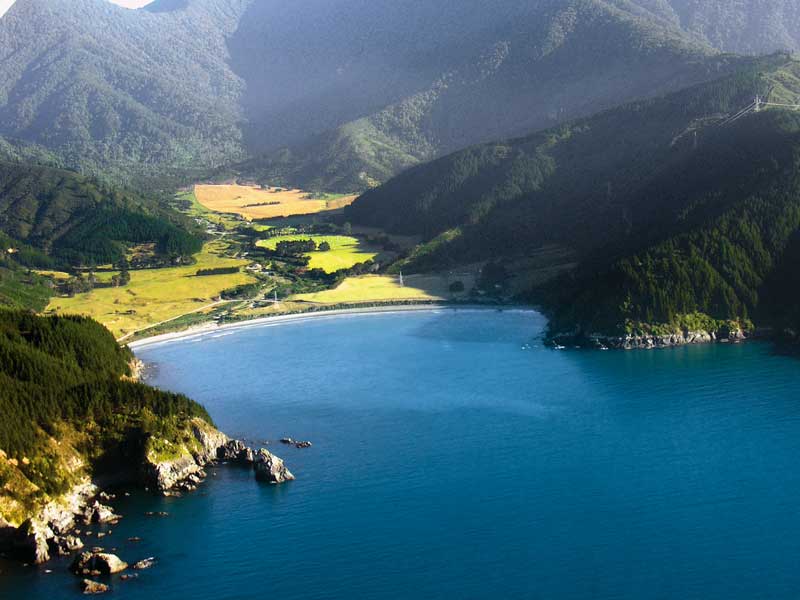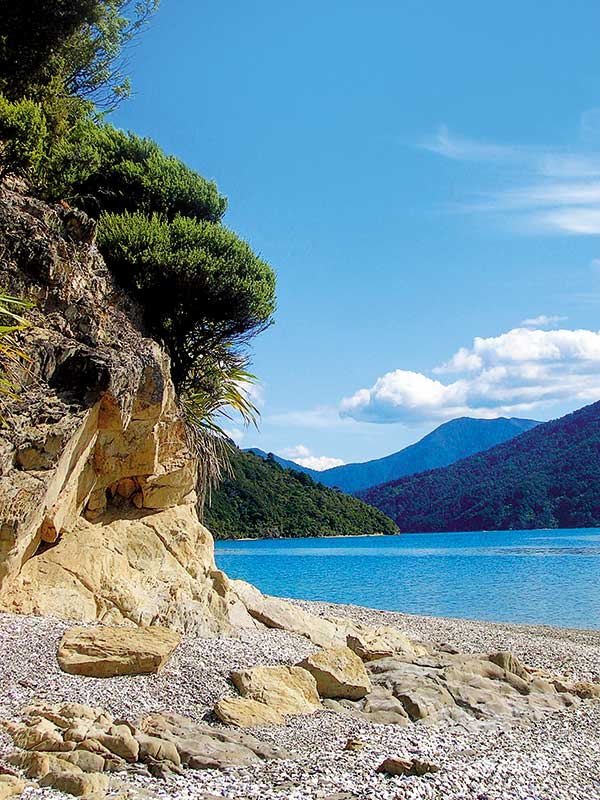At Rai Valley sits a picturesque little reserve, next to the Brown River, where we spent the night parked among a nest of willow trees on the site of William Brownlee’s sawmill (1885 to 1915), although not much of it remains.
From here the drive to French Pass began, first through the lush pastureland of the narrow valley floor that, quite rightly, convinced early pastoralists it would be good place to settle. The flanks of the steep hills on either side were forested with pinus radiata, and where the trees have been harvested, discarded trunks were strewn about the ravaged slopes like spilt matches.
It is a relief then, to climb out of the valley and zigzag sharply through a low beech forest. Already we felt well off the beaten track – any road signs were peppered with gun-shot wounds. At the brow of the hill the first sweeping vista of Croiselles Harbour came into view. Off-shore islands poked up like molar teeth. To one side was the smaller scoop Whangarae Bay set between high pinched headlands, and the swirling sand of a tidal inlet.
It’s steep country through here. What goes up, must come down and a corkscrew descent brought us to the delightful little suntrap of Okiwi Bay. Set at the toe of a sheltered circle of sea with only a narrow outlet to the ocean, the village comprised a scattering of holiday houses, a campground, and wharf.
The road climbed again, higher and higher. On the left a birds’ eye view delivered us the silky, sapphire sea of Outer Pelorus Sound. On the right we could peer down into Hallum Cove and the Inner Sound.
From the turn off to Elaine Bay, the road was unsealed abd for 22km to French Pass, potholes and corrugation gave the motorhome a good shaking. But the seascape is spectacular. Thankfully there were also reserves where the bush was pleasant to drive through, even though it hid the scenery.
And then, quite suddenly, we emerged onto farmland stripped of almost every tree, but smoothly contoured and tilting dizzily down to the far-away ocean. The peninsula had now narrowed to a steep strip of land between Inner and Outer Pelorous Sound. The panorama had us gasping superlatives – to the left the ocean and the great bulk of D’Urville Island, and far down to our right a few monopoly houses in Admiralty Bay and the clear water streaked with mussel farms.
Our road was challenging. It rock-and-rolled towards the tip of the peninsula, slicing through the hills like a narrow linear scar, as if a giant hand had tried to decapitate the hilltops. The sea seemed all around. We were now so high we could have competed with a small plane for airspace. The vistas were amazing. Way below we glimpsed the ginger-coloured sand of beaches impossible to reach except by boat.
Near the road-end, a short walk to a lookout affords the sensational vista of turbulent, fish-filled water that separates D’Urville Island from the mainland. This is French Pass, where swirling currents squeezing through the 800-metre wide passage reach the phenomenal speed of eight knots.
The French Admiral Jules Cesar Dumont D’Urville sailed his corvette, Astrolabe, through here 29 January, 1827. He clipped the reef twice before ‘floating majestically into Admiralty Bay’ and described the dangerous stretch of water as a ‘seething sheet’. The manoeuvre nearly cost him and his crew their lives and is recorded as one of the most astonishing near misses in New Zealand’s maritime history.
Tucked into a cosy bay near the toe of the peninsula is French Pass village, a clutch of holiday houses, a store with a fuel pump, a tiny disused school (1885), a small memorial hall, a wharf, and at one end a farm homestead. A stone plaque by the beach informed me that the expansive farm we’d just driven across is Anaru, and it has been run by the Elmslie and Webber families since 1857, who for better or worse have obviously stuck it out for 153 years in this isolated spot, far from easy street. But it was the end of an era – the farm went up for sale at the end of 2010.
In the bay, bang up against the stony foreshore, is a small but well-organised DOC campground. In March there were more weka lurking about than there were campers. Our neighbour, a misinformed German, couldn’t believe his luck. He’d photographed 11 kiwi, he told me, and I hadn’t the heart to disillusion him.
Spend one night here and you will probably want to make it two. The pace is deliciously slow, but if you want a bit of action there are boats to charter and cruises around the island and the bays, and the fish are said to be the biggest lure of all.









